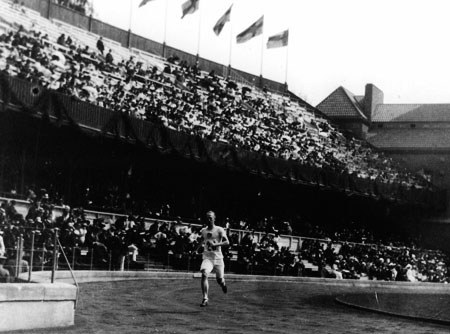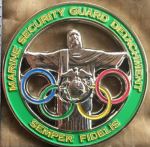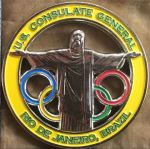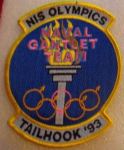Blog Archives
Military Veterans Aiming for Gold: Collecting Olympics Militaria
On the cusp of the 2018 Winter Olympics in PyeongChang, South Korea, I find myself scouring the United States team roster in search of service members (current and former) who are making their way to the icy and snowy venues for this year’s competition. Undoubtedly, as the television production of the games progresses, there will be some special interest stories aired that will cover certain members of Team USA who endured and overcame challenges within their sport on their paths to making the US Olympic Team.
| Veteran | Rank | Unit | Branch | Sport |
| Weber, Nathan | SFC | 10th Special Forces Group | Army | 4-Man Bobsled |
| Olsen, Justin | SGT | NYNG | 4-Man Bobsled | |
| Cunningham, Nick | SGT | 1156 ENG CO | NYNG | 4-Man Bobsled |
| Fogt, Chris | CAPT | Military Intelligence | Army | 4-Man Bobsled |
| Sweeney, Emily | SGT | Military Police | ANG | Luge |
| Mortensen, Matt | SGT | Army | Luge |
When the spotlight of NBC’s coverage shines upon the sledding events (bobsled, luge and skeleton), those feel-good stories very well could include one of more vignettes of the six team USA members who temporarily laid aside their military uniforms in exchange for the read, white and blue skin suits, helmets and spikes for the sledding competition at the Alpensia Sliding Center. Having active duty service personnel and veterans filling spots on Olympics rosters is not a new occurrence for the 2018 team. Some American Olympic competitors were merely civilian, amateur athletes heading into their competitions as was the case with the subject of one of the most compelling and difficult stories of World War II of the experiences of a Southern California track star.
In her 2010 biography, Unbroken, author Laura Hillenbrand’s best-selling work extensively details the life of United States Army Air Force captain, Louis Zamperini and the challenges he faced in the nearly unbelievable life-story. In short, the B-24 that Zamperini was a crew member of, experienced mechanical failures and crashed into the Pacific some 850 miles south of the Hawaiin Islands. Of the 11 crew members, Ernie and two others escaped and spent a harrowing 47 days adrift (one man died) before being picked up by the Japanese. Zamperini would endure two and a half years as a guest of the Emperor of Japan suffering unspeakable abuses, starvation and torture (see the 2014 adapted film, Unbroken).
What does Zamperini have to do with the Olympics? Louis “The Torrence Tornado” Zamperini was a star distance runner from the University of Southern California who placed 8th in the 5,000 meter at the Berlin games in 1936, under Hitler’s watchful eye. Because of his performance at the ’36 games, the Japanese discovered his identity and used his stardom to become the focus of their torture and hatred.

George Patton during the running event of the 1912 Modern Pentathlon (image source: Wired.com).

Patton (at right) fencing (vs Jean de Mas Latrie of France) in the modern pentathlon of the 1912 Summer Olympics (public domain image).
Zamperini’s story aside, I wondered how many U.S. Olympic athletes served in combat. One veteran comes to mind that, for me, has a direct connection to a piece of militaria in my collection. This Olympian finished 5th in the Modern Pentathlon at the 1912 Stockholm summer games behind four Swedes who dominated the event. Second Lieutenant George S. Patton did manage to stir some controversy with the shooting event, opting to use a .38 caliber pistol rather than the more conventional .22-cal. While officially placing 20th, Patton claimed that the rounds which counted as misses had passed through his preceding target strikes. Nevertheless, his low shooting score helped to keep him out of medal contention.
One veteran who competed in two Olympics (1960 Rome and 1964 Tokyo games) as a race walker, has the rare distinction of having been killed in action in the Viet Nam War. West Point graduate (class of 1962), Captain Ronald Zinn, while serving with the 173rd Airborne Division, was killed on July 7, 1965 in a firefight near Saigon. His best Olympic performance was in Tokyo where he placed 6th while competing for his native country, Brazil.
During the summer games in Rio, spectators watched in awe of Michael Phelps’ return to the pool as he racked up five more gold and another silver medal to his already-established record of 22 total. Phelps finished his career with 23 gold, three silver and two bronze medals setting him ahead of the next best (Larisa Latynina of the USSR – 18 total). The all-time greatest Winter Olympic athlete, Ole Einar Bjørndalen, a biathlete from Norway (with 13 medals) has less than half of Phelp’s total. One stat that many Americans will most certainly not know is that prior to Mark Spitz winning his 11th medal at the 1972 games, the sole medal-count (male) leader for the United States was a U.S. Navy veteran.
Naval Academy graduate (class of 1907), Carl Osburn, competed in three Olympic games (Stockholm 1912, Antwerp 1920 and Paris 1924) earning five gold, four silver and two bronze medals in several rifle shooting events. One is left to wonder how many more Osburn would have earned had the 1916 Berlin games not been cancelled due to World War I. In 1936, while in transit from one duty station to another, my uncle was aboard the USS Henderson (AP-1) when Captain Carl Osburn was serving as the ship’s commanding officer which (very) loosely connects pieces of my militaria collection to this Olympic medalist.
Trying to find pieces that cross both militaria and Olympics-collecting can be quite a daunting, if not expensive pursuit for collectors. Due to the extremely small number who competed in the games, anything stemming from one of these veterans will rarely be available for purchase.
- Challenge coin and Olympics collectors would love to have this Marine Corps U.S. Consulate Guard coin from the Rio de Janeiro Olympics (source: eBay image).
- Reverse of the Marine Corps U.S. Consulate Guard coin from the Rio de Janeiro Olympics (source: eBay image).
One crossover aspect (of these two collecting genres) that I appreciate…and is affordable…is the application of the five rings of the Olympic logo on military-related items. I found a handful of aviation squadron patches that either commemorated the games of a specific year or used the logo in a tongue-in-cheek manner.
- The Olympics-theme (the five interlocking rings) is oft-used in many military squadron patches such as this from Lackland, AFB. Perhaps this coincided with the 1996 Atlanta Games (source: eBay image).
- This rather un-politically-correct attempt at humor (and modification of the Olympic interlocking rings) as the fallout resulting from the investigation of the 1991 convention (and scandal) was still in the forefront of naval personnel (source: eBay image).
These patches definitely interest me and leave me searching the web for theater-made Olympic themed patches that might surface from the returning Afghanistan veterans.
Though the games have yet to begin, the nation that is the heavy favorite to bring home the most hardware is Germany due to the IOC-ban that will exclude the 2014 victor, Russia (as a competing nation) due to their systemic cheating via doping (though a smattering of athletes will be allowed to compete if they are determined to be “clean”). The US team is predicted to finish in fourth place behind Norway and Canada, respectively. I will be watching with great hopes that our sledding teams bring home hardware but more importantly, that they honor both their Team USA and Army uniforms.
See more on U.S. troops competing in the 2018 Winter Games:
2018 Winter Olympics: USA Bobsledders, Soldiers have experience on their side
Military police Soldier leads Army’s charge onto 2018 U.S. Olympic Team



